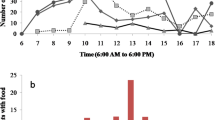Abstract
The aggregation phenomenon is very common in numerous activities of social insects, however, it is often their functional aspects that are studied, leaving their mechanisms not so well understood. With the example of chain formation in Œcophylla longinoda, we present the mechanisms responsible for these collective structures. Our experimental results show that a change in the probability that a worker will decide to join or leave a chain is (1) strongly dependent on the number of ants present in the chain and (2) slightly dependent on the presence of a visual stimulus. The determining role of these probabilities is validated with the use of a mathematical model that reproduces the formation and breakup of the chain. Moreover, it predicts other properties of aggregation such as the influence of nest population size.
Similar content being viewed by others
REFERENCES
Bonabeau, E., Theraulaz, G., Deneubourg, J.-L., Lioni, A., Libert. F., Sauwens, C., and Passera, L. (1998). Dripping faucet with ants. Phys. Rev. E 57: 5904-5907.
Camazine, S., Deneubourg, J.-L., Franks, N. R., Sneyd, J., Theraulaz, G., and Bonabeau, E. (2001). Self-Organization in Biological Systems, Princeton University Press, Princeton NJ.
Darchen, R. (1959). Les techniques de construction chez Apis mellifica. Ann. Sci. Nat. Zool. 12 Ser.: 115-209.
Deneubourg, J.-L., Gregoire, J. C., and Le Fort, E. (1990). Kinetics of the larval gregarious behavior in the bark beetle Dendroctonus micans (Coleoptera: Scolytidae). J. Insect Behav. 3: 169-182.
Gillespie, D. T. (1992). Markov Processes, Academic Press, San Diego.
Gotwald, W. H., Jr. (1995). Army Ants: The Biology of Social Predation, Cornell University Press, Ithaca, NY, p. xviii.
Hölldobler, B., and Wilson, O. (1978). The multiple recruitement systems of the African weaver ant Ecophylla longinoda (Latreille). Behav. Ecol. Sociobiol. 3: 19-60.
Hölldobler, B., and Wilson, O. (1990). The Ants, Springer-Verlag, Berlin.
Ledoux, A. (1950). Recherche sur la biologie de la fourmi fileuse (Ecophylla longinoda Latr.). Ann. Sci. Nat. Zool. 11 Ser.: 313-409.
Sobol, I. M. (1994). A Primer for the Monte Carlo Method, CRC Press, Boca Raton, FL.
Millor, J., Pham-Delegue, M., Deneubourg, J.-L., and Camazine, S. (1999). Self-organized defensive behavior in honey bees. Proc. Natl. Acad. Sci. USA 96: 12611-12615.
Morrill, W. L. (1974). Dispersal of red imported fire ants by water. Fla. Entomol. 57(1): 39-42.
Morse, R. A. (1963). Swarm orientation in honeybees. Science 141: 357-358.
Pasteels, J. M., Deneubourg, J.-L., Verhaeghe, J. C., Boevé, J. L., and Quinet, Y. (1986). Orientation along terrestrial trails by ants. In. Payne, T. L., Birch, M. C., and Kennedy, C. E. J. (eds.), Mechanisms in Insect Olfaction, Oxford University Press, Oxford, pp. 131-138.
Rettenmeyer, C. W. (1963). Behavioral studies of army ants. Univ. Kans. Bull. XLIV(9): 281-465.
Rivault, C., Theraulaz, G., Cloarec, A., and Deneubourg, J.-L. (1999). Auto-organisation et reconnaissance coloniale: le modèle de l'agrégation de la blatte. Actes Colloque Insectes Sociaux, Section française Albi.
Schneirla, T. C. (1971). Army Ants: A Study in Social Organization [Topoff, H. R. (ed.)], Freeman, San Francisco.
Wojtusiak, J., Godzinska, E. J., and Dejean, A. (1995). Capture and retrieval of very large prey by workers of the weaver ant Oecophylla longinoda. Trop. Zool. 8: 309-318.
Author information
Authors and Affiliations
Corresponding author
Rights and permissions
About this article
Cite this article
Lioni, A., Sauwens, C., Theraulaz, G. et al. Chain Formation in Œcophylla longinoda. Journal of Insect Behavior 14, 679–696 (2001). https://doi.org/10.1023/A:1012283403138
Issue Date:
DOI: https://doi.org/10.1023/A:1012283403138




